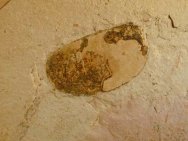Canadaspis
sp. (Phyllocarid fossil)
Phylum
Arthropoda, Subphylum Crustacea, Class Malacostraca, Subclass
Phyllocarida, Order Canadaspidida (1) or Leptostraca, Family Canadaspididae
Geological
Time: Middle Cambrian
Size: 72
mm long
Fossil
Site: Marjum Formation, Millard County, Utah
|  Canadaspis
perfecta a bivalved arthropod also occurring in the Middle Cambrian
Burgess Shale. As a Phyllocarid, it is one of the lesser Canadaspis
perfecta a bivalved arthropod also occurring in the Middle Cambrian
Burgess Shale. As a Phyllocarid, it is one of the lesser known crustaceans from the Cambrian and also among the earliest
animals with a hard shell casing. They had a fairly large carapace
that sheltered the anterior part of the body. This structure hinged
along the dorsal edge like a bivalve. Usually only the carapace
is found. Rarely are the soft parts preserved in the Cambrian shale's
of Utah. This is an extremely fine specimen. The type specimen
of
the genus is Canadaspis perfecta from the Burgess Shale of British
Columbia, Canada (Briggs, 1978). Canadaspis are also known from
the Pioche Shale of Nevada (Lieberman, 2003).
known crustaceans from the Cambrian and also among the earliest
animals with a hard shell casing. They had a fairly large carapace
that sheltered the anterior part of the body. This structure hinged
along the dorsal edge like a bivalve. Usually only the carapace
is found. Rarely are the soft parts preserved in the Cambrian shale's
of Utah. This is an extremely fine specimen. The type specimen
of
the genus is Canadaspis perfecta from the Burgess Shale of British
Columbia, Canada (Briggs, 1978). Canadaspis are also known from
the Pioche Shale of Nevada (Lieberman, 2003).
Also
see: Utah
Cambrian Explosion Fossils Phyllocarid
Branchiocaris pretiosa from Utah Canadaspis
laevigata Arthropod from Chengjiang
References:
Briggs,
D, (1978) The Morphology, Mode of Life, and Affinities of Canadaspis
Perfecta (Crustacea: Phyllocarida), Middle Cambrian, Burgess Shale,
British Columbia. Philosophical Transactions of the Royal Society
of London. Series B, Biological Sciences, Volume 281, Issue 984,
pp. 439-487
Lieberman,
A (2003) New Soft-Bodied Fauana: The Pioche Formation of Nevada.
Journal of Paleontology. 77(4) 674-690.
|
|

 known crustaceans from the Cambrian and also among the earliest
animals with a hard shell casing. They had a fairly large carapace
that sheltered the anterior part of the body. This structure hinged
along the dorsal edge like a bivalve. Usually only the carapace
is found. Rarely are the soft parts preserved in the Cambrian shale's
of Utah. This is an extremely fine specimen. The type specimen
of
the genus is Canadaspis perfecta from the Burgess Shale of British
Columbia, Canada (Briggs, 1978). Canadaspis are also known from
the Pioche Shale of Nevada (Lieberman, 2003).
known crustaceans from the Cambrian and also among the earliest
animals with a hard shell casing. They had a fairly large carapace
that sheltered the anterior part of the body. This structure hinged
along the dorsal edge like a bivalve. Usually only the carapace
is found. Rarely are the soft parts preserved in the Cambrian shale's
of Utah. This is an extremely fine specimen. The type specimen
of
the genus is Canadaspis perfecta from the Burgess Shale of British
Columbia, Canada (Briggs, 1978). Canadaspis are also known from
the Pioche Shale of Nevada (Lieberman, 2003).


